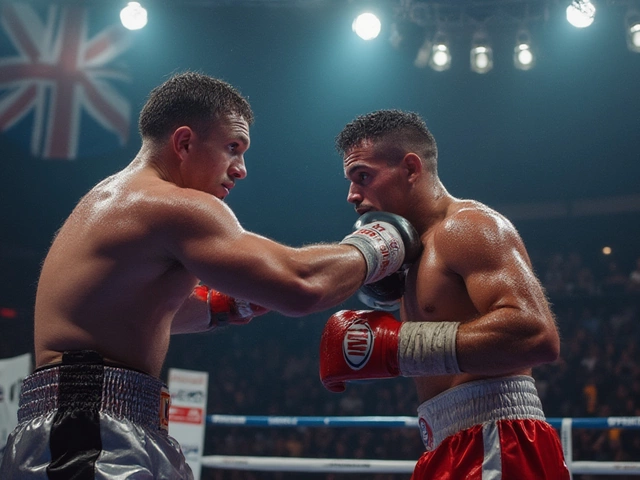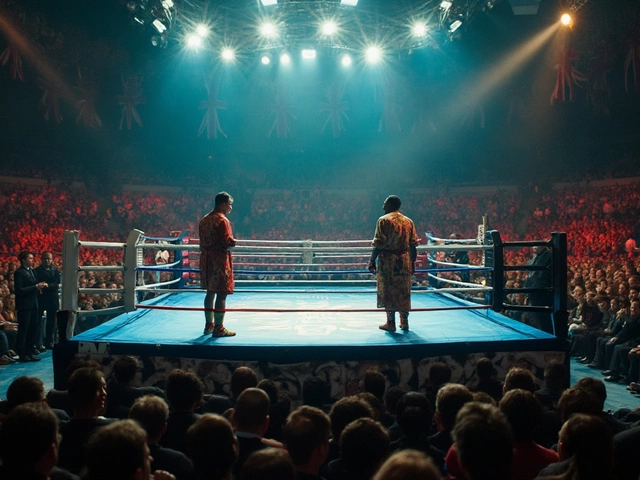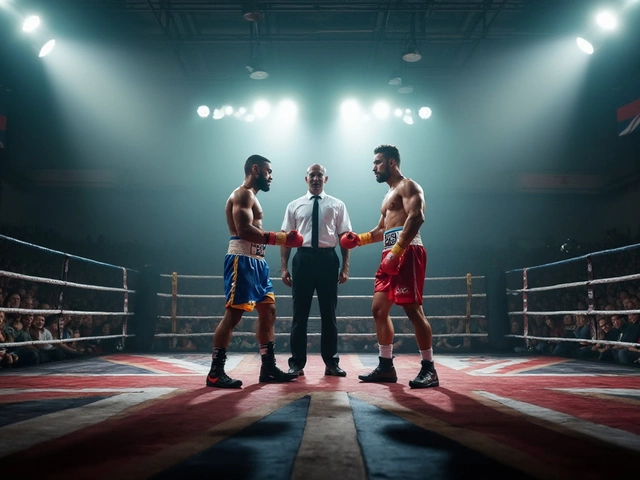Boxing Match Guide: Rules, History, and What Really Happens in the Ring
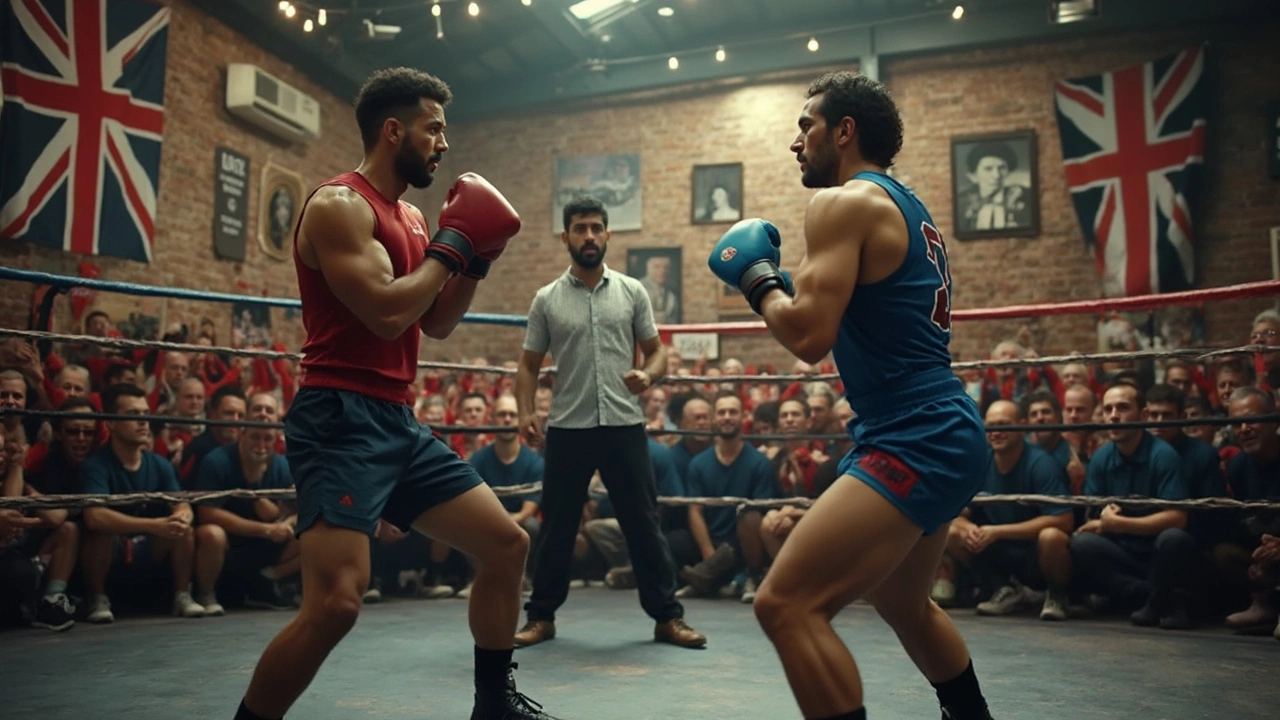
You can feel the tension in the air when the bell rings. Two fighters, dressed in nothing but shorts and gloves, start circling each other inside the squared ring. There's no fancy background music or dramatic light show once things get going—it’s all about skill, grit, and heart. No wonder people pay over $100 for a pay-per-view ticket, or fill 80,000-seat stadiums to catch the action live. Boxing matches aren't just two people throwing punches until someone drops. Underneath the sweat and adrenaline, there are layers of history, strategy, and rules that make this sport both brutal and beautiful.
Breaking Down a Boxing Match: The Real Action
Picture this: the referee checks both fighters for banned substances—no Vaseline except on the face, no jewelry, no nonsense. The gloves must be the correct weight (usually 8 to 10 ounces for pro bouts) and the tape wrapped just right. When the combatants touch gloves, they're signaling mutual respect, but trust me, that’s where the niceties end. The match is split into rounds—typically 3 minutes each, with a one-minute break in between. Pros usually fight for up to 12 rounds, but amateur fights and Olympic bouts are shorter, with 3 rounds being common.
Truth bomb: Most fights don’t end with a dramatic knockout. You’re more likely to see a match go to the judges’ scorecards. Judges award points based on clean punches landed, defense, effective aggression, and ring generalship (which is just a fancy word for 'who controlled the action'). The classic 10-point must system is used: the round winner gets 10 points, the other fighter gets 9 or less.
What actually counts as a winning punch? It has to land cleanly, not get blocked on the arms or gloves. And those body shots you sometimes see ignored in movies—real fighters love them. A well-timed body punch can sap someone’s energy far quicker than a flurry of headshots. Boxers call it 'investing in the bank'—slowly draining the opponent’s stamina until their arms sag and their footwork gets sluggish. Missed shots don’t count, no matter how wild the swing.
If a fighter is knocked down—meaning anything but the soles of their feet touch the ground—the referee gives a count up to ten. Can they get up and continue? Sometimes yes, sometimes they’re out cold. And those infamous ties you sometimes hear fans arguing about? If the judges can't decide, it really can end as a draw. That’s why some boxers prefer to go for the knockout—judges can be human, and sometimes crowds see a fight one way, but the officials see something different.
The ring looks simple but has its own logic. Fifteen to twenty feet on each side, ropes keep fighters from slipping out, but they can also use the ropes to absorb blows and regroup. The referee’s job is high pressure—they have to stop headbutts, low blows, elbows, holding, or rabbit punches. Anything illegal gets a warning, sometimes a point deduction. It’s not a free-for-all by any means.
Between rounds, fighters head back to their corner to get advice and a quick splash of water. Chilling fact: some corner crews carry a special piece of iron to press against swollen eyes, hoping to keep them open long enough to finish the fight. It’s all legal, as long as you don’t use anything that can numb pain (called a 'cut man’s secret') or stop bleeding in an unnatural way. The best cut men can save fights literally with a well-timed dab from a tiny swab.

The Wild History and Growing Culture of Boxing
Boxing isn’t some new-fangled sport created for TV ratings. The earliest records come from the ancient Sumerians and Egyptians, over 4,000 years ago. The Greeks loved it enough to feature it in the original Olympics, though their version—pankration—looked more like a street fight with fewer rules. Fast forward to England in the 1700s, and you have bare-knuckle brawls inside smoky pubs, run by gamblers and watched by anyone who could pay for a spot. The first written rules, called the Broughton Rules in 1743, tried to stop the chaos—no hitting a fallen man, no kicking, and ears weren’t supposed to get bitten. Still, don’t think there weren’t broken jaws and noses aplenty.
Modern boxing as we know it started in the 1860s. The Marquess of Queensberry Rules brought in gloves, timed rounds, and banned wrestling holds. That’s when famous names started popping up. Jack Johnson, the first Black heavyweight champ, fought racially charged battles in the early 1900s. Jack Dempsey filled stadiums in the 1920s. Fast-forward again and you get Muhammad Ali, a man who literally changed the game with his footwork and mouth (yes, that guy could trash-talk better than anyone, and back it up every time).
Boxing kept growing through the decades. Sugar Ray Leonard, Roberto Durán, Mike Tyson—every generation has its legends. Women’s boxing broke through in the 1990s, with Christy Martin and Laila Ali kicking down old doors. By the 2000s, Olympic women’s boxing was a thing, pulling in fighters from all over the world. Now top fights are broadcast in over 150 countries, and even TikTok has turned random fights or training sessions into viral hits. Fans argue every day about the best pound-for-pound fighter alive—Canelo Álvarez, Vasyl Lomachenko, Naoya Inoue, the list goes on. Boxing culture blends street smarts, gym grit, high fashion (yes, check out Tyson Fury's suit game), and deep respect for the men and women risking it all for a win.
Here’s a quirky detail: there are more boxing world titles than fast food chains on a busy street. You’ll see the WBC, WBA, IBF, WBO, and several minor belts. The word 'undisputed' matters—a fighter holding all four major belts in their weight class is considered the king (or queen) of that division. The debate over 'the lineal champ'—the man who beat the man—never stops. This is the sport where, even after someone retires, fans claim it’s only until the next big check comes along.
One of boxing's proudest traditions is the walkout. The crowd buzzes, music blares, sometimes fighters wear masks, national flags, or even gladiator gear. When ring announcer Michael Buffer belts out 'Let’s get ready to rumble!', you can almost feel your chest vibrate. There’s an undeniable drama to it—blood, sweat, high stakes, and the unpredictability of combat. In this ring, reputation, skill, and sheer will are on display for all to see.
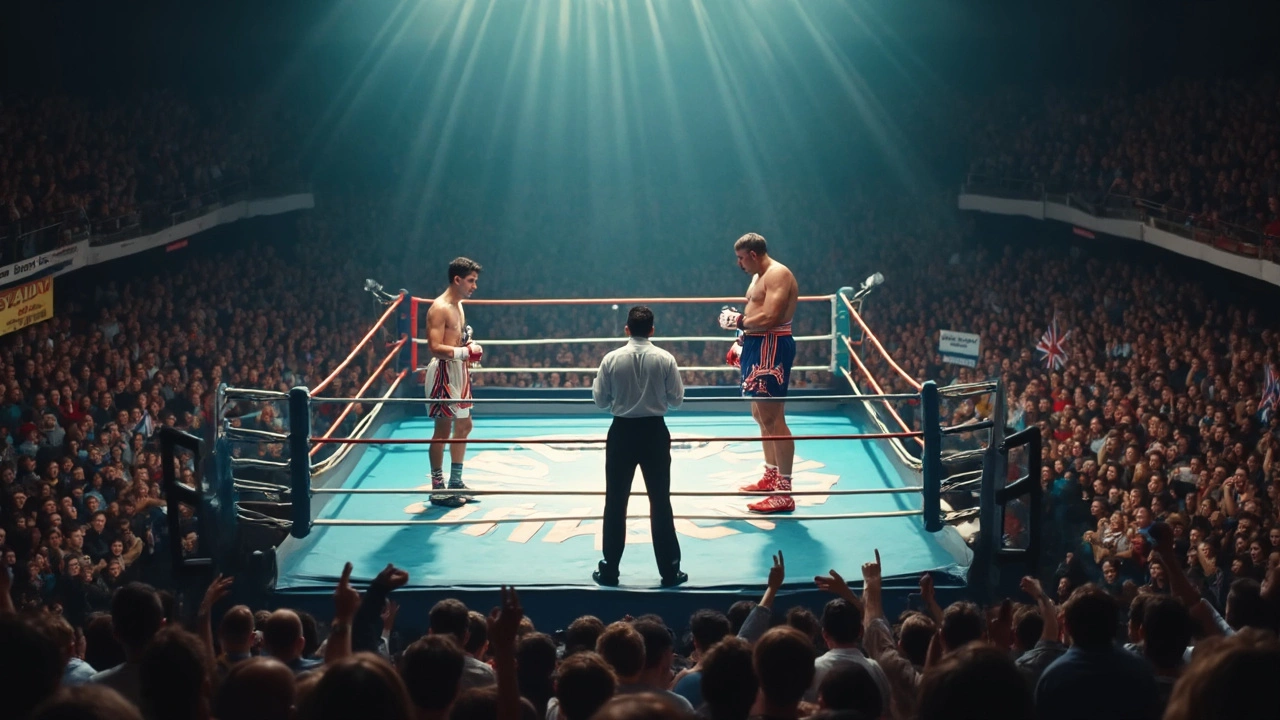
Boxing Pro Tips, Survival Tricks, and Lesser-Known Facts
Starting with an insider tip that surprises most rookies: learning to box is less about throwing punches and more about how you move. Footwork, balance, and timing keep you off the receiving end of trouble. Floyd Mayweather Jr. built a whole career off barely getting hit, all by using head movement and angles. If you ever lace up gloves, try shadowboxing in front of a mirror to spot what you’re doing wrong. The shadow never lies.
It helps to know that boxing is as much mental as physical. Even pros admit to battling fears—fear of getting hurt, fear of embarrassment, fear of losing in front of friends and family. Coaches often say, 'the hardest punch you’ll ever take is the one you don’t expect.' Learning to keep your eyes open (and your chin tucked down) is a key to surviving. Most gyms make you do hundreds of repetitions of basic combos, so you react out of habit, not panic.
If you’re watching live, don’t get fooled by flashy showboating. Sometimes a fighter is simply trying to psyche their opponent out, like Ali’s famous 'rope-a-dope.' But the real drama often happens between rounds, when trainers whisper tactics, tape is adjusted, and spit buckets make their way in and out. Referees also work overtime—checking for blood, stopping fights if a cut looks too bad, or calling in ringside doctors. The safety rules are strict: if someone can’t defend themselves, the match is stopped. No glory is worth a brain injury.
Nutrition plays a wild role here. Many fighters cut 10 to 20 pounds in the week before a bout. They restrict water, hit the sauna, and eat less to make weight. But that rapid loss is dangerous—cramps, fatigue, and even kidney damage can happen if they’re not careful. That’s why pros always work with dietitians and listen to signals from their bodies. After weigh-ins, you’ll often see fighters wolfing down pasta and liters of water to 'rehydrate'—basically turning back into themselves before the big fight.
Here’s what everyone forgets: a good corner team can be a game changer. They don’t just yell instructions; they motivate, spot weaknesses, and sometimes—if a fighter is too stubborn—throw in the towel to save their athlete for another day. Believe it or not, the towel toss is seen as a sign of love, not defeat. Countless boxers thank their coaches for saving their long-term health, even if it stings in the moment.
Some extra facts to drop at your next trivia night: the longest boxing match ever logged was 110 rounds, in 1893. It lasted over seven hours before both guys were too spent to continue. The fastest knockout: Mike Collins iced Pat Brownson in just four seconds back in 1947. The most-watched fight? Mayweather vs. Pacquiao in 2015—over 4.6 million pay-per-view buys in the USA alone, with a gate of over $72 million. And for the record, women's boxing is growing faster now than ever before, and Olympic gold medals can turn regular folks into instant celebrities in their home countries.
Boxing is a sport that’s simple on the surface and wild underneath. The next time you hear the bell ring, watch a little closer. Notice the footwork, the tactics, the brutal chess game happening punch by punch. Whether you’re a hardcore fan or just someone curious about why two people put on gloves and risk it all, there’s always something new to spot. Nothing else matches the electric unpredictability of a well-fought boxing match. If you ever get the chance, try some jabs at the gym—or just keep cheering from the couch. Either way, you’re part of a story that’s been playing out for thousands of years, and there’s always another round waiting.

